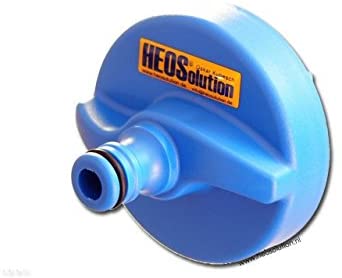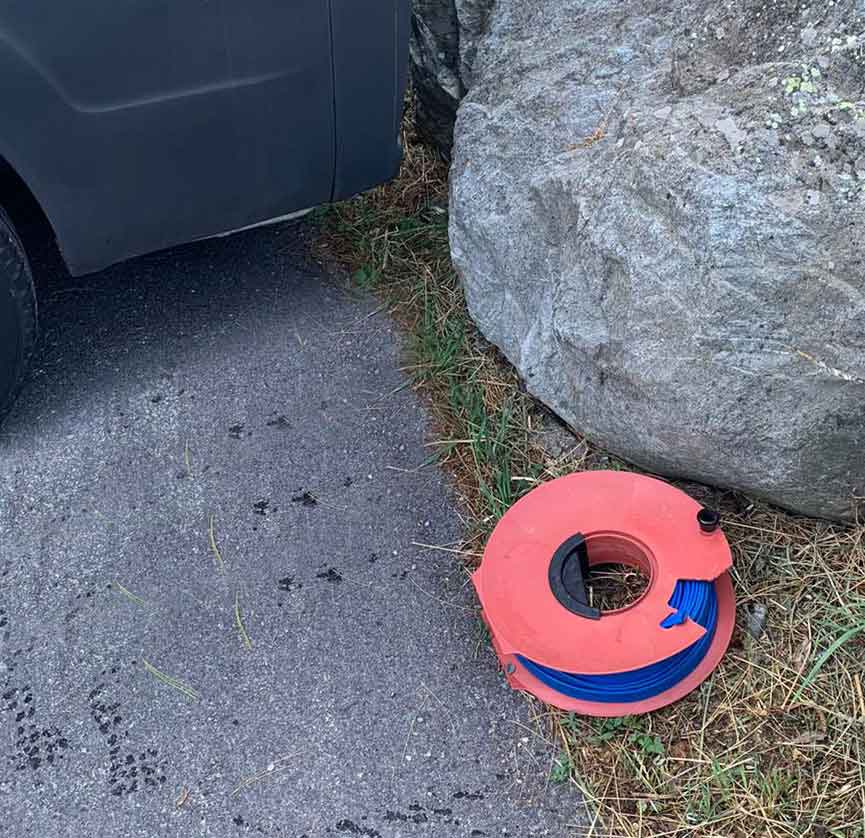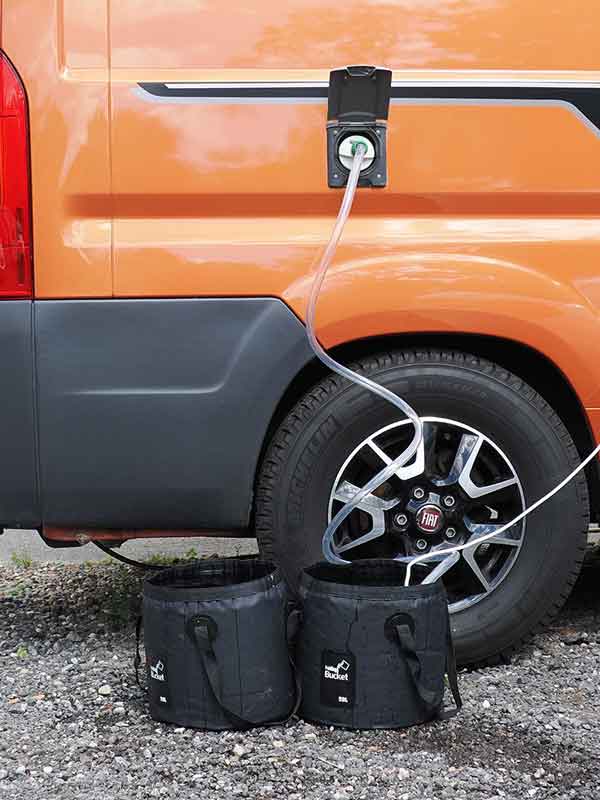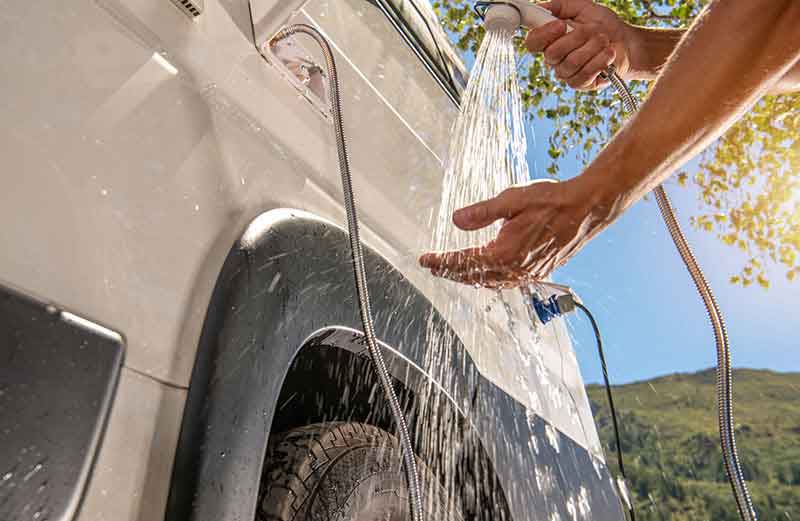Pull into a popular site at changeover time, or arrive at a rally most anytime, and there will very often be a queue at the freshwater tap. If you need water too, this can be a pain, as some motorhome and hose combinations make for r-e-a-l-l-y-s-l-o-w filling.
I have never left home in my motorhome without a completely full water tank.
But that is not the case for many, as their motorhome manufacturers advise them to travel empty. This travel empty thing (or a max 20L) is a lot more commonplace now than it used to be. Why is that?
It’s Because Motorhome Manufacturers are Sneaky Payload Thieves
Well, it’s simple, just a few years ago, no one left home without a full tank of water. When they arrived on site they didn’t have to queue at a water tap, it was already on-board. Their motorhomes were designed to carry water, the tanks were strong and had built in baffles to stop the water sloshing around.
However, a little while ago, a European rule change allowed makers of motorhomes to remove water from their payload calculation. Previously motorhome makers would tell us how much payload we had when we were 90% full with water. Now they can boast about how much payload we have with tanks empty, which means if you fill your 100L tank before you leave home, you are using 100kg of your advertised payload.
Suddenly, some makers are telling us it’s wrong or even dangerous to travel with full tanks.
Thing is,they are right, we should follow their advice. Because now they don’t have to include water in their payload calculations, they can fit lighter, cheaper, non-baffled water tanks.
If like me, you prefer travelling with full tanks, you should ensure you have a strong tank and preferably one that has baffles to stop the water shifting its weight as it sloshes around. If it is strong enough, but has no baffles, then make sure you travel full or empty. I’m reliably advised that big tanks, half full, in the wrong place, might adversely affect handling or braking, though I should say I have never experienced this.
Filling When you arrive on site
The easiest way is to use a short section of hose and park next to the taps on your way in. Always use your own hose whenever possible. You can almost guarantee that some idiot would have had that hose end in or near a toilet cassette.
Hoses and Bugs
Some people disinfect the taps before connecting their hose. After what I have seen over the years, that’s probably a good idea. Always flush the hose before you fill, let the water run through till it’s cold. The tatty looking hose on a busy site that is in constant use, might be safer than the new rarely used hose on a little used CL. Water left in hoses that are warmed by the sun can grow bugs and the deadly Legionnaires Disease, so always drain your hose and be wary of those on site.

Using a cap with a hose connector makes filling easy and saves you having to stick dirty hose ends into your tank.
Some people will only use food grade hoses, others are not so fussy. Though some garden hoses can impart a rubbery taste that ruins a cup of tea. This awful taste can stay in your tank for months. Strangely enough, it doesn’t ruin the taste of coffee.
The most common food grade hose is a blue flat one, these take up a tiny space but they have a couple of limitations.
The first is the flow rate, it is slower than a garden hose and not so good for those of us who are impatient; and second, emptying them.
Before they will fit back onto the cassette they need emptying and it’s a bit like squeezing every last drop of toothpaste out of a 15m toothpaste tube. I never keep the original cassette and wind the hose onto electric cable reels. It takes a little more space, but it’s easy.
A common blue hose solution is one where you don’t have to unroll all the hose, they combine three or four little tubes which ensure that water flows through even when fully wound onto the cassette. These are good, though for me, they can be a little slow; but then my wife does say, I have the patience of a psychopath.
I like to use a full bore hose I cut into three lengths, I then join it with two-way hose connectors. When I unravel my hose. The first 5m there is a junction so if I don’t need it all I can unclip it there.

That 5m length will cope with almost all of my fill ups and means that after each fill I don’t have to roll up a full 25m hose. If I need a bit more, I can unroll another 10M find the next join. If I need it all, then I use the hose will all the joins connected. Rather than the original cassete, I keep 40m on wound onto an old hookup cable tidy. It makes winding it in quick and easy.

How much Hose
Most people carry between 15 and 30m of hose. If you are on a campsite and you find that your 20m of hose is just not long enough, it’s probably the same for your neighbour, so maybe you can join forces and hoses and both fill up. To join a hose to another you’ll need a connector so it is always worth carrying one. They are good for fixing leaks too.
Filling after you have pitched
Most people when they are set up on their pitch don’t want to move the van to get water. Some avoid this by booking fully serviced pitches that have a water tap right on the pitch.
You might get lucky and find yourself in hose pipe distance of a tap, but chances are, your hose won’t be long enough. *So how do you fill up.
A bucket or regular water carrier won’t do, as it’s hard to transfer the contents into your tank without a funnel of some kind. Some people use a right angle piece of drainpipe or a butchered water bottle as a funnel, but it still means they have to lift the water container to chest height to pour it into the tank. This is not ideal.
The Watering Can
The solution for many is a watering can. The spout makes for easy filling and they don’t hold much, so are easy to carry. You’ll see plenty of people using them, You cannot fail to notice them as they pass your pitch 10 times with their little 10L can.
I’ve noticed this watering can person seems to have all the time in the world, nothing better to do and he’ll often whistle an unrecognisable tune as he shuffles back and forth to the tap. He’s happy!
This is not for me. First, the watering can takes up too much room in a locker. Collapsible ones are pretty useless so it has to be a regular garden variety. I suppose, if you have the room for one, and don’t mind walking up and down, then it is a simple way to get water into your tanks, but I think there are better ways.
How I do it
My favourite way if topping up is with a small Caravanners lift pump that is powered by a cigarette lighter socket and 2 x 20L collapsible buckets. I can put 40 L of water into my motorhome in just a couple of minutes. It’s almost as quick as a hose. Do it twice and I’m full. The Buckets and pump pack down into a bag about as big as a large paperback novel. No whistling required.

These collapsible buckets are superb and along with the cigarette lighter powered pump, allow me easily and quickly fill to the brim. Affiliate links to purchse these items are at the bottom of the article.
Getting water out of the tap.
A quick word about taps first. Most motorhome taps no matter how shiny and metallic they look, are cheapo plastic rubbish and above all else, chosen to keep the weight of the van down, so go easy on them they do break and they are very expensive. If ever your van is likely to freeze, make sure your tank is empty and your taps open (pump off) otherwise a tiny bit of ice breaks them really easily. Vans with more payload, and certainly all self build vans will probably opt for a much cheaper, much better, domestic steel tap.
Turn your water pump on so it’s ready to go.
You will either have a pressurised or a switched system. In pressurised systems, your tap is a valve, as you opening it, the water, which the pump has held under pressure is forced out. As soon as the pump notices the loss of pressure it kicks in and re-pressurises the system, it will continue operating for just a second of so after you turn off the tap.
In a pressurised system, tiny amounts of air can escape the plumbing which means this type of setup can be guilty of re-pressurising the system, hardly noticeable by day, but at night just as you are dozing. Two barrps from the pump , a loud vibrating water-pipe, and you’re wide awake! For this reason many people turn their water pump off at night.
With a pressurised system, if you have a water leak, the pump will assume a tap is on and keep the pressure up until the tank is emptied though the leak. So if you hear the pump and there are no taps are operating. Switch the pump off immediately and investigate.
In a switched system, each tap has a tiny switch within, so as you turn on the tap, electricity gets to the pump which pumps water out of your tap. This system is simple to spot as two wires will come from the tails of each tap. These switches are more robust than you might imagine and can last a long time.
Should I drink right out of the tap?
The world is split between those who drink direct from their tank via their tap, and those who wouldn’t dream of it. A similar split is between those who regularly sterilise their water tank, and those who never have. There is no right or wrong, it’s just what you are comfortable with.
We’ll fill a kettle and clean our teeth using the water from the tank. For neat drinking, or squash etc, we have a water container on board. I have never cleaned a freshwater tank. Nor put sterilising tablets in it.
If you have that horrible rubber taste in your tank, A Brita Jug filter will remove it. There are various inline filter systems, mostly aimed at improving taste, but some claim to remove all sorts of nasties. Most people don’t have one installed.
Some people put sterilising tablets in their water, it makes them feel better; most don’t bother. I’d rather not clean my teeth in something that tastes like the school swimming pool. Most anywhere you travel in UK and Europe the water is good quality.
When things go wrong
There is not too much to go wrong with the water systems, but I’ll mention a few common issues
Your water gauge doesn’t reflect reality,
This is true of most motorhomes, take what your gauge says with a pinch of salt. After a while you’ll instinctively have a better idea about how much water is in your tanks than your gauge.
You are full but nothing comes out of the tap
You probably have an airlock, a common occurrence that can be frustrating to solve. There is no one way to solve it because it depends on your setup. But have a read of these threads and you’ll have a good idea about how to fix it.
Water Trouble shooting
As you fill water is coming out of the bottom of your van
This could be one of a few things.
- Has the drain tap has been opened? This tap will be at a low point in your water system and its there to drain your system in case of frost.
- The least likely reason is a water leak, but it can happen
- The tank is full and the overflow is operating!
- Common and frustrating! Your water heater Dump Valve has operated. See below:
The last item an inbuilt safety feature built into your water heater to prevent from frost damage. This is good as they are very expensive to replace or repair. Except annoyingly, the water might dump at “chilly” rather than freezing. So if the temperature last night dropped to below 6 degrees, you may have to reset this. Look at these threads for help how to do that.
CLICK> Will my Truma Boiler dump the water if it gets cold
Hi, my Truma dumps and empties the water tank automatically once the temperature drops. I also have a blue switch next to the boiler I can flip to do this myself. I was telling a friend and we started to look at theirs but couldn’t see a similar switch. They have a Truma Trumatic C, I have…
CLick>Water pouring from a pipe -Hymer
I am sure I am being an idiot, but after a long very stressful day my brain is fried and I’ve lost the ability to think clearly. I am trying to refill the water system after the winter drain down on Hymer B504, I think I’ve reset the trauma heater/boiler correctly (turned it and pressed the…


